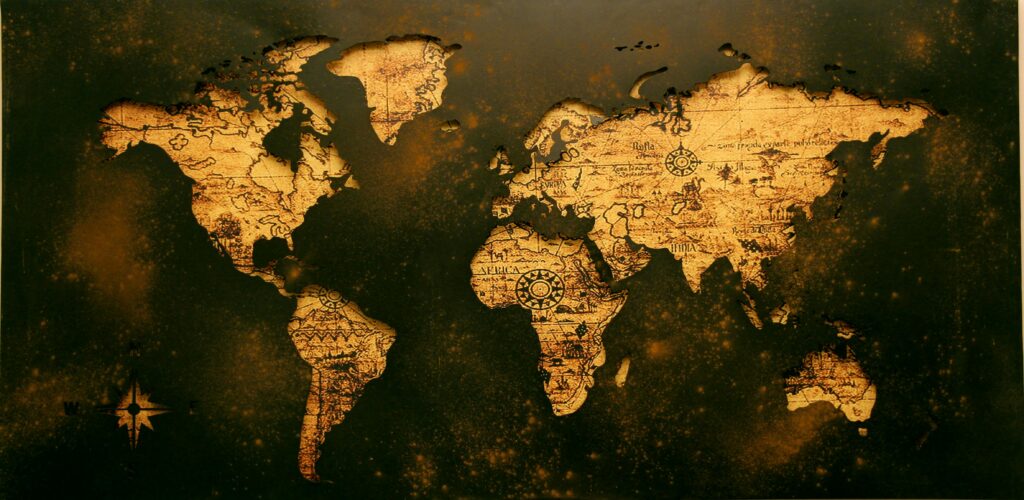How Ancient Trade Routes Shaped Global Empires
Introduction
Trade routes have been super important throughout history. They were like the highways of the ancient world, connecting faraway places, cultures, and ideas. These routes weren’t just for trading goods; they also helped spread new ideas and beliefs. Big empires grew and got stronger because they controlled these trade paths. This post will explore where these trade routes started, how they influenced powerful empires, and their lasting impact on our world today.
The Origins of Trade Routes
Silk Road: Connecting Asia to Europe
The Silk Road was more than just a path; it was a big link between different parts of the world. It started in ancient China and stretched over 4,000 miles, going through tough deserts and tall mountains, to connect Asia with Europe. Here are some key points:
- Development and Goods Traded: During the Han Dynasty, the Silk Road was used to trade silk, spices, tea, and precious stones. These items were so valuable that empires wanted to make new friends and opportunities.
- Cultural Exchanges: Besides trading goods, the Silk Road was a place where cultures mixed. Buddhist monks traveled west to share their teachings, while Zoroastrianism and Nestorian Christianity moved east. Art, technology, and ideas blended together, making cultures richer.
Maritime Trade Routes
Sea trade was another important way the ancient world was connected. Maritime routes were just as crucial as those on land.
- Mediterranean Network: The Greeks, Phoenicians, and later the Romans used the Mediterranean Sea to trade olive oil, wine, and precious metals, creating a lively economic community around the water.
-
Indian Ocean Links: From Africa to Southeast Asia, the Indian Ocean routes let people trade textiles, spices, and jewelry. With better ships and tools like the compass, these sea routes helped connect Eastern and Western parts of the world.
Key Empires Influenced by Trade Routes
The Roman Empire
The Roman Empire became strong partly because it controlled important trade networks in the Mediterranean.
- Urban Development: Cities like Alexandria and Constantinople became main centers for trade and culture, filled with riches and ideas from other places.
-
Military Expansion: The wealth from trade helped the Romans grow their military strength and expand their territory.
-
Cultural Integration: Different cultures mixed in Roman society, bringing poetry, new technologies, and food diversity.
The Mongol Empire
The Mongol Empire created a very secure trade network during its peak period.
- Expansion and Security: Under Mongol rule, the Silk Road became safer, reopening old trade routes and boosting economic growth.
-
Economic Prosperity: The Pax Mongolica, or Mongolian Peace, allowed goods, ideas, and travelers to move freely across Eurasia, enriching the empire.
-
Cultural and Intellectual Exchange: Trade brought scholars, artists, and adventurers. Knowledge, like using paper money and new medical ideas, spread widely.
The Ottoman Empire
The Ottoman Empire thrived by controlling both sea and land trade routes.
- Strategic Domination: Covering parts of Europe, Asia, and North Africa, the Ottomans had control over key spice and silk trades, which strengthened their economy.
-
Cultural Transformations: Art, food, and ideas created a vibrant and diverse Ottoman world, fueled by continuous exchanges.
Economic Impacts of Trade Routes
Trade routes helped create new economies and cities.
- Introduction of Goods: Items like pepper from India, silk from China, and gold from Africa changed local markets and how people lived.
-
Urbanization and Trade Centers: Cities like Venice, Baghdad, and Samarkand thrived as major trading hubs thanks to the bustling activity trade routes brought.
-
Agriculture and Production: The need for new goods changed farming habits, improved production techniques, and affected labor systems.
Cultural and Technological Exchange
Trade helped different cultures mix and spread knowledge around.
- Spread of Religions: Religions like Buddhism, Islam, and Christianity were carried to distant places by traders.
-
Exchange of Scientific Knowledge: Innovations in subjects like math, medicine, and astronomy traveled far, impacting many civilizations.
-
Influence on Art and Literature: Art styles, building techniques, and literature swapped and blended, leading to unique cultural periods in various regions.
Challenges and Dangers of Ancient Trade Routes
Even though they were beneficial, ancient trade routes had dangers.
- Political Instability: Wars and changing alliances could stop trade, as borders changed with the fates of empires.
-
Bandits and Piracy: Bandits threatened land routes, while sea paths faced piracy, making protection expensive.
-
Environmental Obstacles: Traders faced harsh deserts, tough mountain passes, and dangerous seas, making long-distance trade risky.
The Decline and Transformation of Trade Routes
Over time, ancient trade routes changed or became less important.
- Factors Leading to Decline: New political powers, invasions, and new routes led to the fall of traditional trade paths.
-
Age of Exploration: Discovering sea routes to Asia and the Americas changed trade focus, causing routes like the Silk Road to decline.
-
Legacy: Even though they declined, ancient trade routes have left a lasting mark on today’s global trade, showing how interconnected the ancient world was.
Conclusion
Ancient trade routes played a huge part in shaping history, helping empires rise and spread cultures and innovations. Their legacy can still be seen in our modern globalized world, reminding us that human connections and exchanges have always been key to civilization, crossing borders and oceans to create a shared human story.
Further Reading and Resources
- Books: “The Silk Roads: A New History of the World” by Peter Frankopan, “Sea Peoples: The Minoans and the Sea Trade” by Kathryn Bard.
-
Documentaries: “The Silk Road: Past, Present, Future” (BBC Series), “The Spice Trail” with Kate Humble.
-
Online Resources: National Geographic’s interactive map on ancient trade routes.
History fans, explore the past! Visit ancient trade routes, historical ports, and caravansaries to learn more about how these paths influenced today’s global interactions. Join the discussion: How are today’s trade systems similar to those of the past? Let’s start exploring!

